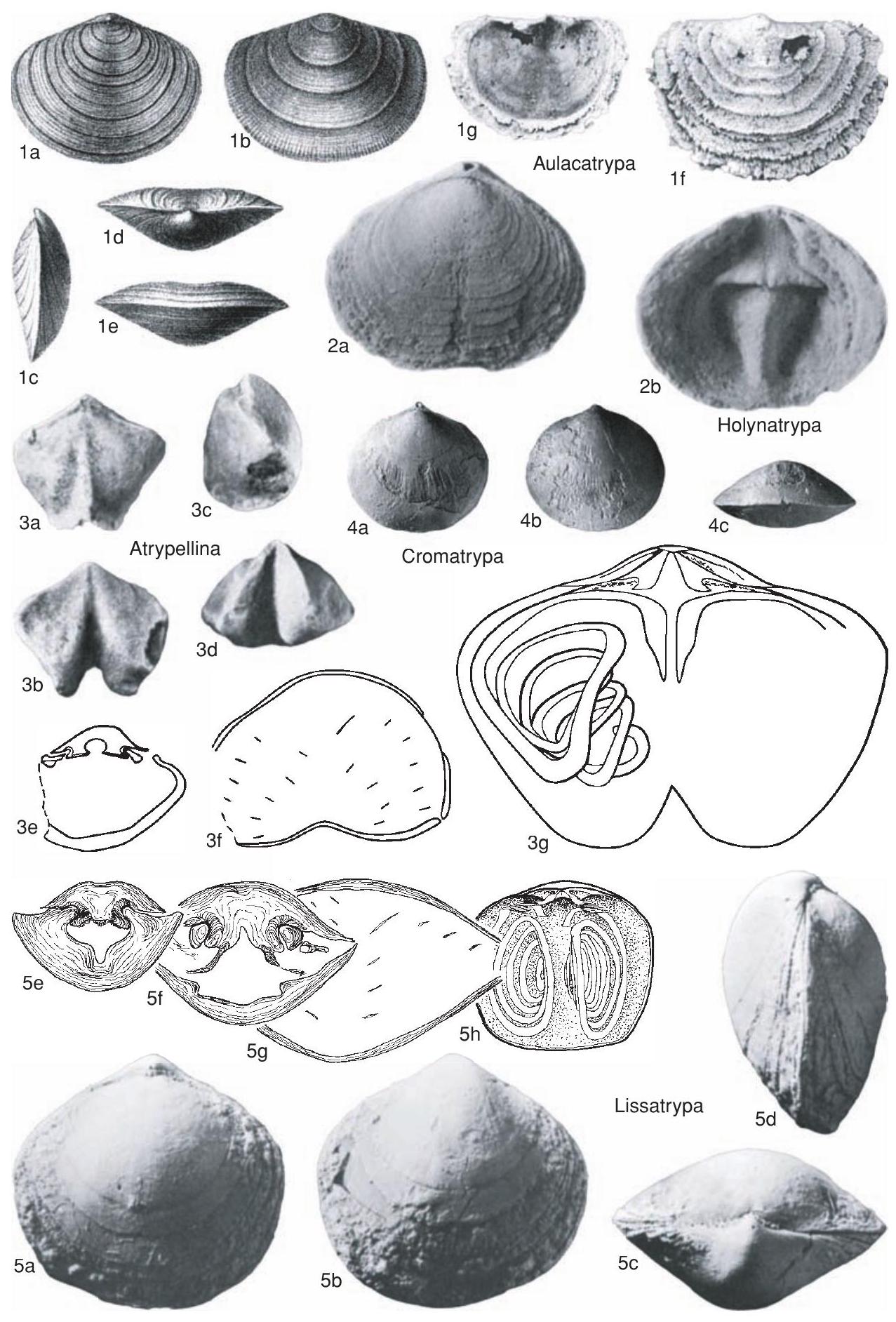Welcome to the Treatise on Invertebrate Paleontology!
Please enter a genera name to retrieve more information.

Lissatrypa
Classification
Phylum:
Brachiopoda
Subphylum:
Rhynchonelliformea
Class:
Rhynchonellata
Order:
Atrypida
Suborder:
Lissatrypoidina
Superfamily:
Lissatrypoidea
Family:
Lissatrypidae
Formal Genus Name and Reference:
Lissatrypa TWENHOFEL, 1914, p. 31
Type Species:
L. atheroidea TWENHOFEL, 1914, p. 33, OD
Images
(Click to enlarge in a new window)
Fig. 989, 5a-h. *L. atheroidea, middle Llandovery, Anticosti, Canada, a-d, dorsal, ventral, posterior, lateral views, x3 (Copper, 1973a), e-g, serial sections, x5, h, reconstruction of brachidia, x3 (new).
Synonyms
Spondylobolus, ?Loilemia, Nanospira, Lissatrypoidea, Buceqia, Solitudinella
Geographic Distribution
worldwide
Age Range
Beginning Stage in Treatise Usage:
Silurian (middle Llandovery)
Beginning International Stage:
Aeronian
Fraction Up In Beginning Stage:
66
Beginning Date:
439.24
Ending Stage in Treatise Usage:
Middle Devonian (Eifelian)
Ending International Stage:
Eifelian
Fraction Up In Ending Stage:
100
Ending Date:
385.3
Description
Small to medium, biconvex-dorsibiconvex-planoconvex, usually smooth (shells may preserve fine, concentrically aligned, radial capillae), apical to transapical foramen, small deltidial plates (commonly resorbed or covered by beak in adult shells), rectimarginate to gently plicate commissure, thick shell wall, pedicle callist, distinct collar, muscle scars commonly deeply incised, may be separated by septum, with V-shaped ventral adductors, short, solid teeth, thickened to bulbous hinge plate, cardinal pit commonly lost, overgrown or suppressed by massive crural bases in adult shells, covered by small cardinal process, dorsomedial spiralia with fewer than 7 to 8 whorls, short, bulky, posterior jugal processes terminating in thick, ringlike jugal plates. [Differs from Australina in thick shell, nature of hinge plate, pedicle callist-collar. The name Spondylobolus has not been used in more than 140 years and is abandoned.]
References
Museum or Author Information
Classification
Phylum:
Brachiopoda
Subphylum:
Rhynchonelliformea
Class:
Rhynchonellata
Order:
Atrypida
Suborder:
Lissatrypoidina
Superfamily:
Lissatrypoidea
Family:
Lissatrypidae
Formal Genus Name and Reference:
Lissatrypa TWENHOFEL, 1914, p. 31
Type Species:
L. atheroidea TWENHOFEL, 1914, p. 33, OD
Images
(Click to enlarge in a new window)
Fig. 989, 5a-h. *L. atheroidea, middle Llandovery, Anticosti, Canada, a-d, dorsal, ventral, posterior, lateral views, x3 (Copper, 1973a), e-g, serial sections, x5, h, reconstruction of brachidia, x3 (new).
Synonyms
Spondylobolus, ?Loilemia, Nanospira, Lissatrypoidea, Buceqia, Solitudinella
Geographic Distribution
worldwide
Age Range
Beginning Stage in Treatise Usage:
Silurian (middle Llandovery)
Beginning International Stage:
Aeronian
Fraction Up In Beginning Stage:
66
Beginning Date:
439.24
Ending Stage in Treatise Usage:
Middle Devonian (Eifelian)
Ending International Stage:
Eifelian
Fraction Up In Ending Stage:
100
Ending Date:
385.3
Description
Small to medium, biconvex-dorsibiconvex-planoconvex, usually smooth (shells may preserve fine, concentrically aligned, radial capillae), apical to transapical foramen, small deltidial plates (commonly resorbed or covered by beak in adult shells), rectimarginate to gently plicate commissure, thick shell wall, pedicle callist, distinct collar, muscle scars commonly deeply incised, may be separated by septum, with V-shaped ventral adductors, short, solid teeth, thickened to bulbous hinge plate, cardinal pit commonly lost, overgrown or suppressed by massive crural bases in adult shells, covered by small cardinal process, dorsomedial spiralia with fewer than 7 to 8 whorls, short, bulky, posterior jugal processes terminating in thick, ringlike jugal plates. [Differs from Australina in thick shell, nature of hinge plate, pedicle callist-collar. The name Spondylobolus has not been used in more than 140 years and is abandoned.]
